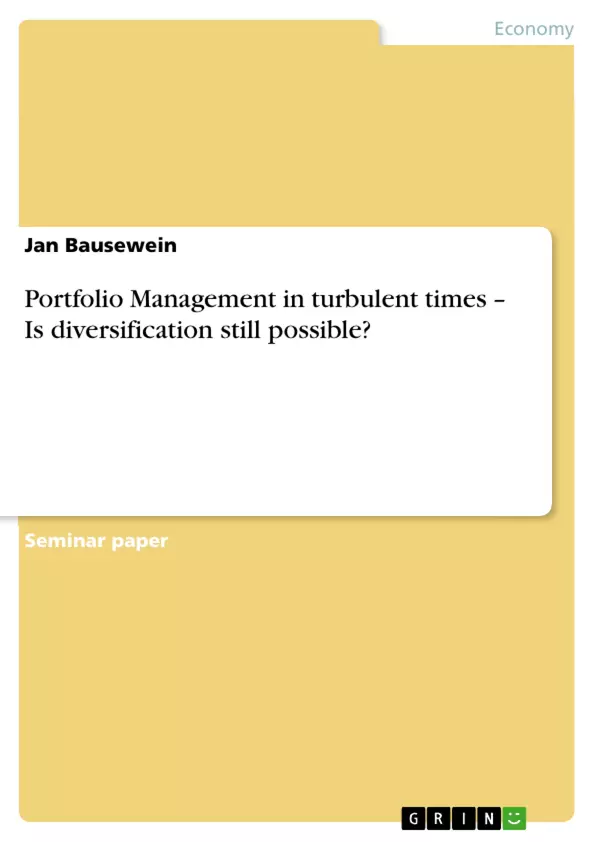Looking at the newspaper and television reports on stock prices and their highs and lows in the various economic phases of recent years, it seems hardly surprising that an ambivalent impression of the events surrounding the stock market has taken root in the minds of a large part of the population. In accordance, newspapers and television repeatedly report on the one hand about miraculous increases in wealth caused by the strong and sometimes sudden rise of various stock prices. These reports force the question on one or the other, why one still works, since the earning of the large money at the stock exchange seems to be simple finally. On the other hand, the financial markets have been shaken again and again by crises, which have provided ample proof that it is not advisable to leave the earning of money to stocks alone.
Harry Markowitz, American economist and professor, is still one of the pioneers in the field of capital market theory with his modern portfolio theory (MPT). Every investor faces the hurdle of finding the most efficient portfolio. In this case, liquidity, risk and the expected return play the central triangle. Both the own risk awareness, which correlates with the return, and exogenous influences, such as in turbulent times, have an impact on the portfolio and its result. Markowitz and his MPT states that the reason for this is that the professional selection of securities in an investment portfolio within the framework of asset management reduces the risk of the portfolio in comparison to the risk of the individual securities. Accordingly, no one needs to fear the financial markets as long as he does not pay more attention to the individual securities than to the securities portfolio as a whole.
This paper provides an understanding of portfolio management, especially in turbulent times. The central question is whether diversification of the portfolio is still possible. What exactly diversification is and how to build an efficient portfolio with asset classes will be explained in the following chapters of this paper.
The reader should gain a solid understanding about portfolio management. For this purpose, some terminology will be explained in the theory part, which will then be applied in practice in the further course. Finally, possibilities are shown how to hedge one's portfolio in volatile times.
Inhaltsverzeichnis (Table of Contents)
- Introduction
- Theoretical foundation
- Portfolio Management / Correlation of Assets
- Volatility and Risk
- Diversification and Efficiency Curves
- Practical analysis: Portfolio management in turbulent times
- Sample portfolio in turbulent times
- Is diversification still possible?
- Opportunities to hedge in volatile times
- Futures / Forwards/Swaps / Options
- Further Hedging / Diversification
- Conclusion
Zielsetzung und Themenschwerpunkte (Objectives and Key Themes)
This paper explores the concept of portfolio management, particularly in turbulent economic periods. The main goal is to understand whether diversification remains a viable strategy in volatile markets. The paper will delve into the principles of portfolio management, analyze a sample portfolio, and examine opportunities for hedging in volatile times.
- Portfolio Management and its principles
- Correlation of assets and its impact on portfolio risk
- The role of diversification in portfolio efficiency
- Strategies for hedging in volatile markets
- The viability of diversification in turbulent times
Zusammenfassung der Kapitel (Chapter Summaries)
The introduction sets the context by highlighting the importance of portfolio management and its relevance in volatile markets. It introduces Harry Markowitz and his Modern Portfolio Theory (MPT), emphasizing the role of diversification in reducing portfolio risk. The chapter outlines the objectives and scope of the paper.
The theoretical foundation chapter provides a detailed explanation of portfolio management principles, including correlation of assets, volatility and risk, and diversification. It delves into the concept of efficiency curves and their relationship to portfolio diversification. This chapter establishes the theoretical framework for the subsequent analysis.
The practical analysis chapter examines portfolio management in turbulent times, using a sample portfolio to illustrate key concepts. It explores the question of whether diversification remains possible in such volatile environments.
The opportunities to hedge in volatile times chapter discusses various hedging strategies, including futures, forwards, swaps, and options. It also explores other methods of hedging and diversification.
Schlüsselwörter (Keywords)
This paper focuses on portfolio management, diversification, risk management, and hedging strategies in turbulent economic times. Key themes include Modern Portfolio Theory (MPT), correlation of assets, volatility, efficiency curves, and asset classes. The paper also explores the viability of diversification in volatile markets and examines various hedging instruments such as futures, forwards, swaps, and options.
- Quote paper
- Jan Bausewein (Author), 2022, Portfolio Management in turbulent times – Is diversification still possible?, Munich, GRIN Verlag, https://www.grin.com/document/1240148



